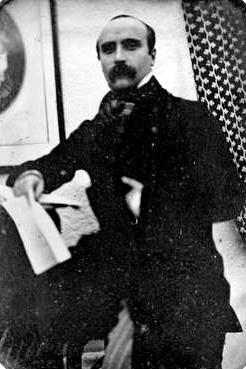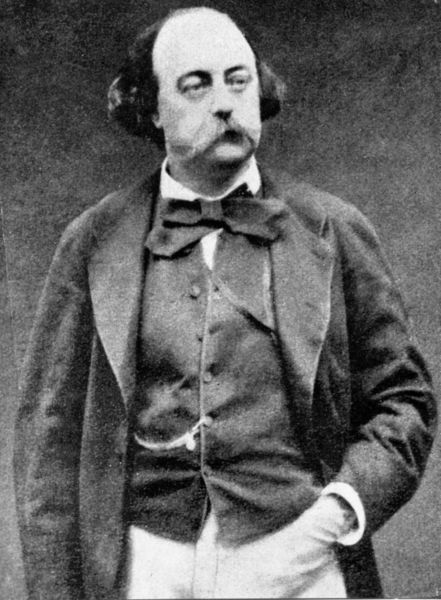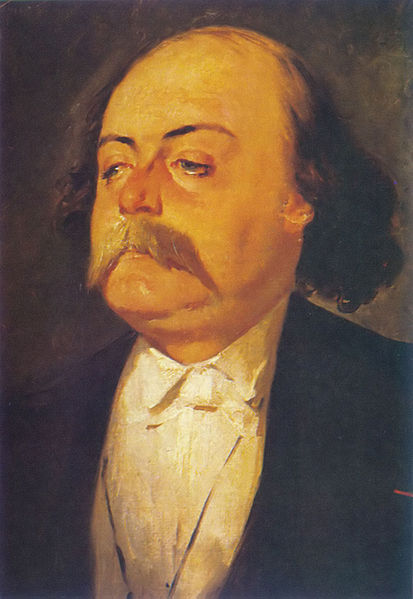<Back to Index>
- Chemist Alfred Werner, 1866
- Novelist Gustave Flaubert, 1821
- Major General Alexandros Ypsilantis, 1792
PAGE SPONSOR



Gustave Flaubert (December 12, 1821 – May 8, 1880) was a French writer who is counted among the greatest Western novelists. He is known especially for his first published novel, Madame Bovary (1857), and for his scrupulous devotion to his art and style.
Flaubert was born on December 12, 1821, in Rouen, Seine-Maritime, in the Haute-Normandie region of France.
He was the second son of Achille-Cléophas Flaubert (1784 – 1846),
a surgeon, and Anne Justine Caroline (née Fleuriot) (1793 – 1872).
He began writing at an early age, as early as eight according to some
sources. He was educated in his native city and did not leave it until 1840, when he went to Paris to study law. In Paris, he was an indifferent student and found the city distasteful. He made a few acquaintances, including Victor Hugo. Towards the close of 1840, he traveled in the Pyrenees and Corsica. In 1846, after an attack of epilepsy, he left Paris and abandoned the study of law. From 1846 to 1854, Flaubert had a relationship with the poet Louise Colet (his letters to her survive). After leaving Paris, Flaubert returned to Croisset, near the Seine,
close to Rouen, and lived with his mother in their home for the rest of
his life; with occasional visits to Paris and England, where he
apparently had a mistress. Flaubert never married. According to his
biographer Émile Faguet, his affair with Louise Colet was his
only serious romantic relationship. He sometimes visited prostitutes. Eventually,
the end of his affair with Louise Colet led Flaubert to lose interest
in romance and seek platonic companionship, particularly with other
writers. With his lifelong friend Maxime du Camp, he traveled in Brittany in 1846. In 1849 - 1850 he went on a long journey to the Middle East, visiting Greece and Egypt. In Beirut he contracted syphilis. He spent five weeks in Constantinople in 1850. He visited Carthage in 1858 to conduct research for his novel Salammbô. Flaubert
was a tireless worker and often complained in his letters to friends
about the strenuous nature of his work. He was close to his niece,
Caroline Commanville, and had a close friendship and correspondence with George Sand. He occasionally visited Parisian acquaintances, including Émile Zola, Alphonse Daudet, Ivan Turgenev, and Edmond and Jules de Goncourt. The 1870s were a difficult time for Flaubert. Prussian soldiers occupied his house during the War of 1870, and his mother died in 1872. After her death, he fell into financial straits. Flaubert suffered from venereal diseases most
of his life. His health declined and he died at Croisset of a cerebral
hemorrhage in 1880 at the age of 58. He was buried in the family vault
in the cemetery of Rouen. A monument to him by Henri Chapu was unveiled at the museum of Rouen. In September 1849, Flaubert completed the first version of a novel, The Temptation of Saint Anthony. He read the novel aloud to Louis Bouilhet and Maxime du Camp over
the course of four days, not allowing them to interrupt or give any
opinions. At the end of the reading, his friends told him to throw the
manuscript in the fire, suggesting instead that he focus on day to day
life rather than on fantastic subjects. In 1850, after returning from Egypt, Flaubert began work on Madame Bovary. The novel, which took five years to write, was serialized in the Revue de Paris in
1856. The government brought an action against the publisher and author
on the charge of immorality, which was heard during the following year,
but both were acquitted. When Madame Bovary appeared in book form, it met with a warm reception. In 1858, Flaubert traveled to Carthage to gather material for his next novel, Salammbô. The novel was completed in 1862 after four years of work. Drawing on his childhood experiences, Flaubert next wrote L'Éducation sentimentale (Sentimental Education), an effort that took seven years. L'Éducation sentimentale, his last complete novel, was published in 1869. He wrote an unsuccessful drama, Le Candidat, and published a reworked version of La Tentation de Saint-Antoine, portions of which had been published as early as 1857. He devoted much of his time to an ongoing project, Les Deux Cloportes (The Two Woodlice), which later became Bouvard et Pécuchet, breaking from the obsessive project only to write the Three Tales in 1877. This book comprised three stories: Un Cœur simple (A Simple Heart), La Légende de Saint-Julien l'Hospitalier (The Legend of St.Julian the Hospitaller), and Hérodias (Herodias). After the publication of the stories, he spent the remainder of his life toiling on the unfinished Bouvard et Pécuchet,
which was posthumously printed in 1881. It was a grand satire on the
futility of human knowledge and the ubiquity of mediocrity. He believed
the work to be his masterpiece, though the posthumous version received
lukewarm reviews. Flaubert was a prolific letter writer, and his
letters have been collected in several publications. At the time of his death, he may have been working on a further historical novel, based on the Battle of Thermopylae. Flaubert
scrupulously avoids the inexact, the abstract, the vaguely inapt
expression which is the bane of ordinary methods of composition. As a
writer, Flaubert was nearly equal parts romantic, realist,
and pure stylist. Hence, members of various schools, especially
realists and formalists, have traced their origins to his work. The
exactitude with which he adapts his expressions to his purpose can be
seen in all parts of his work, especially in the portraits he draws of
the figures in his principal romances. The degree to which Flaubert's
fame has extended since his death presents an interesting chapter of
literary history in itself. He is also accredited with spreading the
popularity of the colour Tuscany Cypress, a colour often mentioned in
his chef-d'oeuvre Madame Bovary. Flaubert was fastidious in his devotion to finding the right word ("le mot juste"),
and his mode of composition reflected that. He worked in sullen
solitude - sometimes occupying a week in the completion of one page -
never satisfied with what he had composed, violently tormenting his
brain for the best turn of phrase, the final adjective. His private
letters indeed show that he was not one of those to whom correct,
flowing language came naturally. His style was achieved through the
unceasing sweat of his brow. Flaubert’s just reward, then, is that many
critics consider his best works to be exemplary models of style. Flaubert's lean and precise writing style has had a large influence on 20th century writers such as Franz Kafka through to J.M. Coetzee. As Vladimir Nabokov discussed in his famous lecture series: This
painstaking style of writing is also evident when one compares
Flaubert’s output over a lifetime to that of his peers (for example Balzac or Zola).
Flaubert published much less prolifically than was the norm for his
time and never got near the pace of a novel a year, as his peers often
achieved during their peaks of activity. The legacy of his work habits
can best be described, therefore, as paving the way towards a slower
and more inspective manner of writing. The publication of Madame Bovary in
1856 was followed by more scandal than admiration; it was not
understood at first that this novel was the beginning of something new:
the scrupulously truthful portraiture of life. Gradually, this aspect
of his genius was accepted, and it began to crowd out all others. At
the time of his death he was widely regarded as the most influential
French Realist. Under this aspect Flaubert exercised an extraordinary
influence over Guy de Maupassant, Edmond de Goncourt, Alphonse Daudet, and Zola.
Even after the decline of the Realist school, Flaubert did not lose
prestige in the literary community; he continues to appeal to other
writers because of his deep commitment to aesthetic principles, his
devotion to style, and his indefatigable pursuit of the perfect
expression. He can be said to have made cynicism into an art form, as evinced by this observation from 1846: His Œuvres Complètes (8 vols., 1885) were printed from the original manuscripts, and included, besides the works mentioned already, the two plays, Le Candidat and Le Château des cœurs. Another edition (10 vols.) appeared in 1873 – 1885. Flaubert's correspondence with George Sand was published in 1884 with an introduction by Guy de Maupassant. He has been admired or written about by almost every major literary personality of the 20th century, including philosophers and sociologists such as Pierre Bourdieu and Jean Paul Sartre whose partially psychoanalytic portrait of Flaubert in The Family Idiot was published in 1971. Georges Perec named Sentimental Education as one of his favourite novels. The Peruvian novelist Mario Vargas Llosa is another great admirer of Flaubert. Apart from Perpetual Orgy, which is solely devoted to Flaubert's art, one can find lucid discussions in Vargas Llosa's recently published Letters to a Young Novelist.